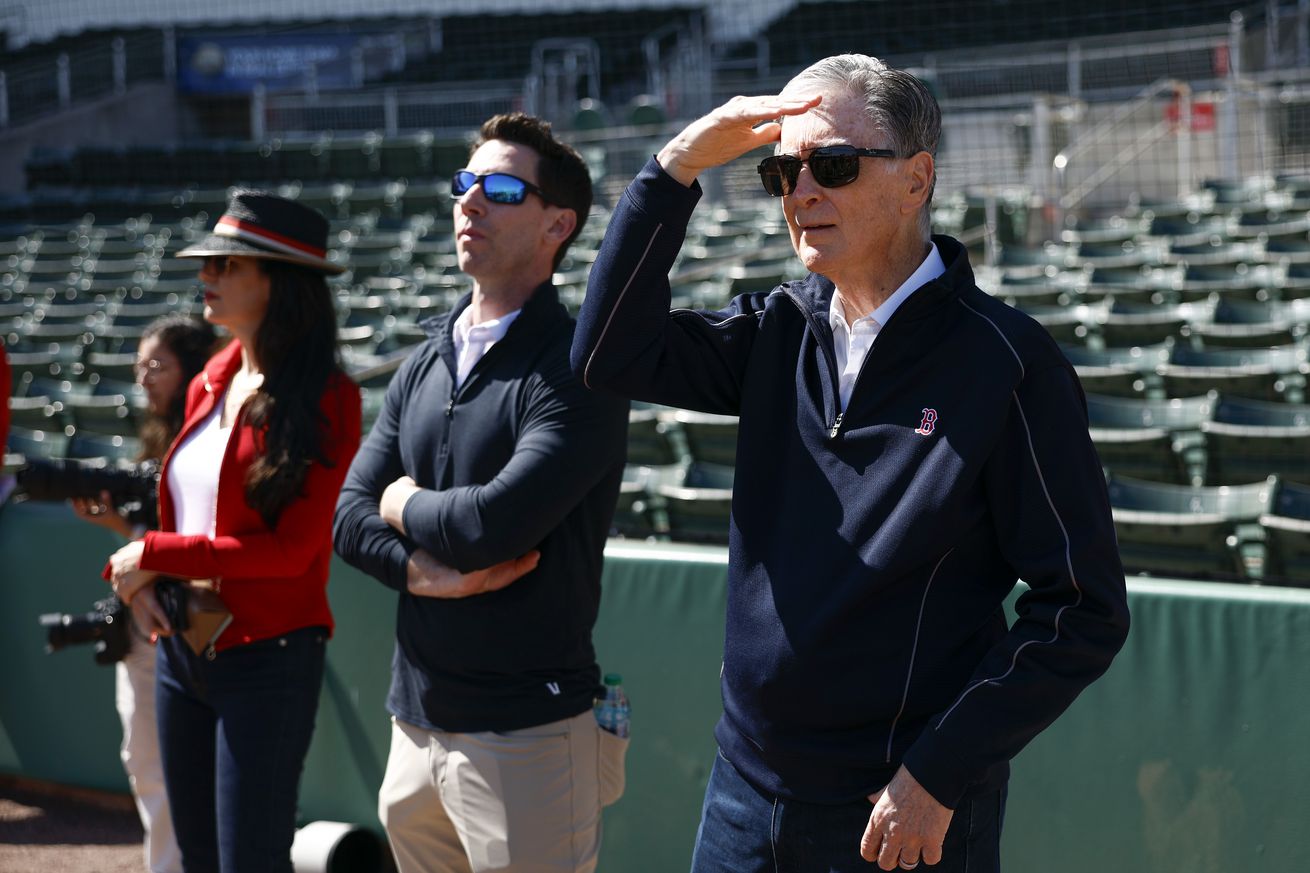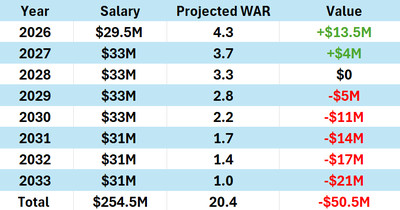
Can the Red Sox win championships simply with numbers? Well, I guess we’re going to find out.
Each member of every MLB roster simultaneously exists on three parallel planes of existence: The player, the person, and the asset. These spheres of influence move like trains traveling down parallel sets of track, and fans are free to hop between them whenever they please, although the admission price to board the last one includes your soul, so be careful as you take the tour through this article.
There’s often overlap between these realms, but sometimes there’s just not. So when a fault line ruptures, like it did with the Rafael Devers trade on Sunday, it’s worth diving into the stark differences between the worlds, and exploring how the impossible and the ordinary can coexist across places trapped in each other’s gravity.
First off though, it’s important to note it wasn’t always like this. For most of baseball history, the Venn diagram representing the difference between baseball player and baseball asset was almost a clean circle. There may have been plenty of owners who wanted to harvest out the value piece of the pie, but the tools just didn’t fully exist for it yet.
But then something quietly momentous happened, and it irrevocably changed baseball forever. The WAR stat, representing Wins Above Replacement, was created, perfected, and married to the finance element of the game. This chain of events ultimately culminated in the disastrous decoupling between baseball players being viewed as assets because they’re productive in terms of helping their team win on the field, and baseball players being viewed as assets because they have value in relation to the WAR stat and the contract they’re being paid.
For the first time, the people with all the power could not only measure the value of a win and generally agree on it, but could also project it into the future and figure out the exact moment the flow of surplus value on any large contract was likely to switch away from the penny pinching owner, and towards the decaying player.
Before this metric took over the sport, baseball players still had value attached to them. The albatross contract was a thing, owners were greedy as ever, and fans routinely had their hearts broken. But there was much less agreement between the powers that be on how the numbers added up and what took precedence, particularly when breaking things down by percentage. One team may have prioritized power hitting while the next liked batting average, and there wasn’t an easy way to smooth out this difference between clubs when it came time to trade or pay players.
This created a world where there was always a race to get the BEST players. Now, with the finance of the game fully invested in the data of the game, the goal is to wait things out and get the most VALUE in any deal. Within this young but also lifeless plane of existence, there’s little disagreement of what each established veteran with a large contract is worth as an asset on a balance sheet. It’s just a matter of how much you give in to the math when team building vs. how much you value the men in the locker room. For many clubs, their players aren’t people. They’re just a number, preferably one with a green dollar sign in front of them.
This troubling reality brings us to the disconnect between what’s happening inside the Red Sox front office and what’s happening in the world of Red Sox fans when it comes to the Rafael Devers trade. While there’s always been a disconnect on two planes of existence with these kinds of moves, I’d argue there are now three.
First, you have the personal, emotional plane. This is the one where everything matters more, where life is worth living, where seeing Devers smile after hitting a 450 foot bomb against the Yankees makes you feel things, and where the inner clubhouse dynamics play out. This is also the one that’s most complex, and given the wide variety of opinions on Devers, is best to put aside for a moment (we’ll get back to it for a bit at the end, I promise).

Photo by Billie Weiss/Boston Red Sox/Getty Images
Then you have the pure baseball player plane of existence. The one where Devers makes raw contributions to the team with a specific skillset in the here and now. In this existence, Rafael Devers is extremely and undeniably valuable, and in a different era, that’s probably enough to keep him in a Red Sox uniform (unless he was pure poison in the clubhouse, which while he was far from an angel, doesn’t seem to hit the mark).
Wednesday, Over The Monster’s own Bob Osgood went into detail about this part of the Devers story, and in doing so created a strong case as to why Boston’s model missed the mark on its longest tenured player. Bob even does some of that gory math (and brace yourself, there’s a little more coming here in a moment) explaining why Devers was so valuable to this current roster.
Unfortunately, nobody making decisions on Jersey Street has a foot in that world anymore. Instead, they’ve moved on to that third plane of existence — the depressing, dismaying, dystopian hellscape, where players aren’t people you should get attached to and superstars who win ballgames aren’t necessarily valuable. It’s in this world where we find Rafael Devers the asset.
Now again, since WAR is not only current, but also very projectable into the future, we can make a pretty educated guess as to when a baseball asset might turn sour. For simplicity purposes, I’m going to run the equation here for the rest of Rafael Devers’ contract using the $10 million cost per win figure Bob used Wednesday. We’ll then also sprinkle in the ZiPS WAR projection numbers created by Dan Szymborski for the Fangraphs article by Ben Clemens linked here.
This table below is the result, and it represents the only thing that matters in the world of Rafael Devers the asset (I‘ve added some color to make it look a little more appealing):

This is why the Red Sox wanted to dump the entire contract. It was not only imperative, but also urgent. The team didn’t just view this as a negative $50 million piece of baggage over the next eight years right now, but also as something about to become a near $70 million piece of negative baggage for five long years following 2028.
It’s very important to understand here that the negative value in the contract is time specific. Rafael Devers, even in this world, is a positive asset in the short term, and this is what makes him appealing and moveable to a club like San Francisco. However, the WAR projection coupled with the concrete contract say that time is limited, and the closer you get to the sunset point (in this case the end of 2028) the more likely you’re going to be the one left holding the bag.
So in the baseball-is-a-business and therefore baseball-players-are-only-assets world, the most efficient way to run your club is to move on from guys right before other teams who are more concerned with winning in the immediate future find the backside of the contract intolerable. So in this disturbing cacotopia, the Red Sox actually just painted the Mona Lisa!
There have to be members of this data driven front office who are looking at this deal and laughing so loud it can be heard clear across the country; but it’s also probably at a pitch you can only make out if you remove your soul from your body.
The conversations in there must be wild: “Look at these idiots in San Francisco! They can’t get any hitting stars to take their money in their desperate attempt to keep up with the Dodgers. Couldn’t land Bryce Harper, didn’t get Aaron Judge across the finish line, only finished over .500 once in the last eight years, and now they’re willing to take on this toxic asset after we’ve already burned two and a half of the good years of the extension. We gave them a ticket to the party when there was only 30 minutes left and then forced them to sign a clause where they have to stay for four hours afterwards where they’ll be left to do the dishes and clean the toilets. Fabulous work gentlemen!”

Photo by Billie Weiss/Boston Red Sox/Getty Images
This behavior is why the Red Sox follow a very disturbing pattern of parting with star players. They’ve always valued the business and the finance side of things ever since a guy with a finance background bought the team, but now they have the tools that can better pinpoint when the contracts flip from positive assets to negative ones on an annual bases, and they’re putting them to use on a hyperactive level. In a world where the owner now manages the Red Sox as part of a global portfolio and has increasingly strained relationships with former allies in the organization, that third plane of existence where players are nothing more than assets is the only place he’s capable of existing.
But back here in the world of peasants and plebs, spending an eternity on that side of the tracks feels noxious and untenable. There needs to be more of a balance, or at least an explanation as to why there isn’t one.
On Monday, Matt McCarthy tried to dig this up on the virtual conference call between the team and the media. Unfortunately, despite having the most interesting question of the night, Sam Kennedy greeted him with the most boring answer.
Say what you will about the response, but I give the Sox credit for letting the guy most known for kicking them out of the city after an 0-3 start ask them questions about baseball.pic.twitter.com/H9pzA9xSKe
— Matt McCarthy (@MattMcCarthy985) June 17, 2025
But we can all read between the corporate gobbledygook lines here: The Red Sox live in the baseball players are assets more than people world, and there, repeatedly parting with Hall of Fame talent isn’t a bug in the system, it’s a feature! Hall of Fame talent gets paid beyond — sometimes well beyond — the point in which it remains capable of still producing Hall of Fame talent. So what does any unfettered capitalist running a baseball team do with that information? They make it a priority to dump the contract obligation on some other sucker just before the math flips.
This is the real reason why it almost always ends ugly with the Red Sox and star players. During this ownership, we’ve seen Nomar Garciaparra, Pedro Martinez, Manny Ramirez, Josh Beckett, Adrian Gonzalez, Jon Lester Mookie Betts, Xander Bogaerts, and now Rafael Devers all end up on other teams, and it’s mostly because the Fenway Sports Group was done paying them in one form or another.
John Henry and the Red Sox aren’t so much in the business of winning championships, they’re in the business of value collecting. (As an aside, this is also why so many of the individual moves Craig Breslow makes look pretty darn good, but the pieces on the roster don’t seem to fit together as one cohesive unit. If they see value, they pull the trigger. If they don’t, they refuse to take 80 cents on the dollar and just awkwardly ride with what they have.)
Now the Sox would probably refute this point by correctly pointing out that simply collecting value correlates extremely strongly with winning championships, and while that’s true retroactively looking at baseball history, it also ignores two critical points:
1) The Red Sox have been slowly sliding down the list of team payroll obligations for the better part of a decade now. Unless this Devers money is reinvested elsewhere, these practices go from ugly but efficient to a complete scam. The whole point of ruthlessly pursuing payroll space is so you can fill that vacuum with other guys who contribute to winning, not so you can further enlarge John Henry’s bank account.
2) Goodhart’s Law, which states the following:
”When a measure becomes a target, it ceases to be a good measure”
In other words, as more and more teams in baseball switch from being championship driven organizations to “find the value in contracts” organizations, some other metric will emerge as the best measuring stick to winning the World Series. And because the pendulum across the entire sport has swung so ridiculously far to the “baseball players are assets” plane, it just might be something in the personal/emotional/intangible world that emerges to fill the space.
If this does occur, and Goodhart’s law manages to upend the forces that fueled Devers’ departure, are the Red Sox willing and able to pivot? Or will they just continue to believe that their value harvesting program will pay dividends in the long run?

Photo by Danielle Parhizkaran/The Boston Globe via Getty Images
Meanwhile, what becomes of us all if Goodhart’s law doesn’t strike?
For more on that, let’s take a look at what Coley Mick of the Section 10 Podcast had to say about the Devers trade, and specifically what he and other superstars have meant to the Red Sox fanbase:
“It means more to us… The whole reason we become fans is because of players like Rafael Devers.”@ColeyMick perfectly sums up how we’re feeling about the Raffy trade. pic.twitter.com/8vF0opl5s2
— Section 10 Podcast (@Section10Pod) June 17, 2025
He would then go on to say “adults couldn’t be adults.”
Adults couldn’t be adults https://t.co/TTBWjN2olX
— Céad Míle Fáilte (@ColeyMick) June 17, 2025
Here’s my fear: What if the adults just act like this now? Worse yet, what if they’re constantly rewarded for it? What if the only way to get a seat at the baseball table is to treat the guys the rest of us root for on a daily basis like dirt, and the only people left to feel the pain and scream in the night are the ones who refuse to sell their souls to the relentlessly efficient corporate machine?
In other words, what if John Henry, Craig Breslow and the rest of the Red Sox front office are right?